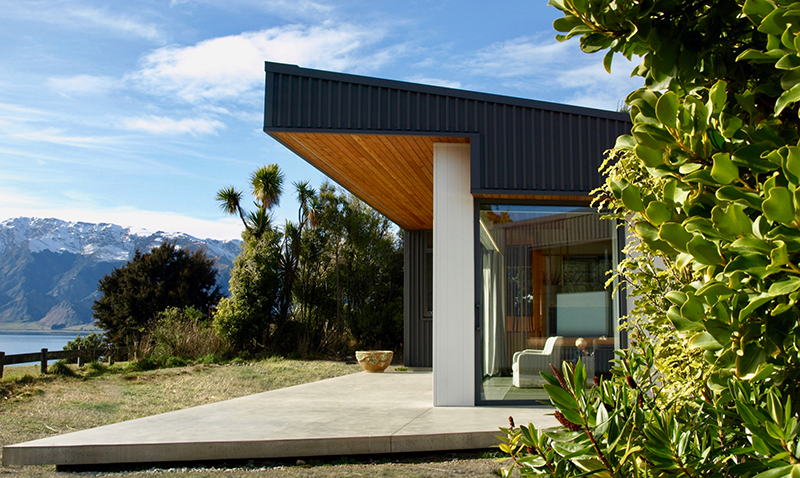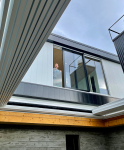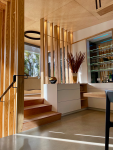Views To Lake Hawea Are The Stars Of This Scandinavian Influenced Home

A house should work as a home and be beautiful: when you walk into a space it should make you feel something. Such is the design philosophy of Wellington-based MJWarchitecture (MJW) principal Mark Warren, an approach that has had significant influence in designing The View House at Lake Hawea, Queenstown Lakes.
Architect Mark responded to the client’s design brief for a holiday home to accommodate several families at once – for the house to become a multi-generational haven for the client’s families to visit.
An absolute priority was to maximise the setting and location of the site with incredible and ever changing seasonal views of Lake Hawea. The view was to be the star of this 326sqm, four bedroom family home – every room afforded this vista as per the client’s directive. The only parts of the house without the view are the entrance way, laundry and downstairs toilet and shower.
The View House has four bedrooms, a family bathroom with separate WC, media room, a downstairs WC with shower, laundry, master suite with ensuite and dressing, open plan kitchen, dining and lounge built around the internal courtyard plus a viewing deck with an office nook.
Early design work began in December 2018 starting with a single level dwelling in a V shape with a central courtyard but much tinkering followed with site plans, steps, different floor levels and material options, some of the many iterations to get what the client wanted.
By far the biggest challenge was the site itself. The clients are farmers on a sheep and beef property in Taihape. They have travelled extensively in the South Island for sheep dog trials and skiing trips and regularly stayed at the Hawea Hotel when they discovered the section over the road for sale. It would become theirs to establish a holiday home and eventually their retirement home. An old building on the site had once been a DOC information centre and sat alongside a large pine tree.
The shape of the site was awkward, flanked by a busy Capel Avenue on one side and a public walkway on Crown Land on another. There was also a protected view shaft caveat passing through the north west corner of the site so not building was permitted there.
“These elements meant we had a very squeezed site, hence the shape of the house so we could fully utilize what land was available but still provide some semblance of privacy”, says Mark. “It was very challenging but the best feature was that the site was flat.”
Mark had to balance privacy with access to view making placement of The View House the single most important element of the project. To mirror the mountains across the lake, Mark included angled walls in the master suite and lounge which added another element of privacy.
To comfortably cater for family groups to be together the home features an internal covered courtyard with an openable louvre roof. Along with the kitchen, dining and lounge all are built around the courtyard responding to how the owners would cater for large family groups. The courtyard is where the large pine tree was removed.
Mark was known to the clients (parents of friends of his) having designed a major renovation of their 150 year-old homestead at Moawhango so it helped that Mark understood the couple’s very different ends of the style spectrum. John wanted traditional schist and many timber elements while Robin sought a Scandinavian feel to the internal spaces - definitely no schist and no tiles anywhere in the home!
The building is low maintenance with material choices unifying the home with different features including input from a lighting designer for the linear lights in the halls and layers of light to suit the mood of the location and setting.
Roofing and cladding was significant to the mix – governed by the fact that the lower roof could be viewed from upstairs. Dimond’s surface-fixed LT7 in Colorsteel Tidal Drift matte grey was specified for both horizontal and vertical surfaces providing a pristine, straight and angular finish facilitating the insertion of skylights. Colorsteel corrugate in Ebony is a feature of the courtyard chimney. There are no timber fascias – they are formed from folded Colorsteel with folded swages for rigidity. The windows are set back into the cladding creating a tight, thermal envelope to the home. Even with changes to H1 energy efficiency codes, this home features elements that far exceed the new requirements. Exterior cladding also included Nu-Wall aluminium E series (black) and Mono 200 series (black and white) profiles.
Adding to the Scandinavian design influence, Siberian larch has been used for the rusticated weatherboards on parts of the home’s cladding, a timber similar to cedar and which contains good amounts of natural oils which burn when they come to the surface creating an interesting texture which is very stable. Soffits have similarly been created from oiled Siberian larch.
The client Robyn was closely involved in the design and material choices for the kitchen featuring an island with no insertions of sink or appliances, opposite a long work bench at the back and a scullery – and no tiles anywhere so a smokey grey mirror splashback in the kitchen and Hardies InVibe wall linings in the showers.
MJWarchitecture
Essex born, Mark worked in construction from the age of 18 – glazing East End schools to building movie sets in the US. He was a carpenter and builder but always hankered to become an architect having worked in Calgary, Los Angeles and Miami Beach before settling in New Zealand in 1998. When a back injury put paid to further carpentry work, Mark at age 42, and with the support of wife Sia Aston, committed to study at Victoria University and graduated in 2014 with a Masters in Architecture.
He served his time at several practices in Wellington including working under Gerald Parsonson (Parsonson Architects) - Mark’s dream job - until January 2020 when he established his own practice MJWArchitecture just before the Covid lockdown His goal is to specialize in bespoke residential design and The View House is the first under his practice.
“Every project I undertake, if completed successfully, will give the clients the sense that they have something unique, something designed specifically for them to enhance and enrich their lives, whether that’s in their new home or reinventing an existing one.”


